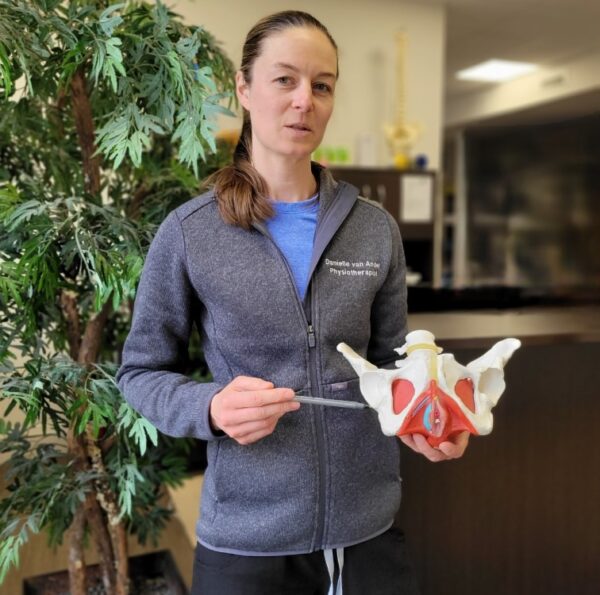
Pelvic Floor Physiotherapy
Pelvic floor physiotherapy is an effective treatment for incontinence, pelvic pain, pelvic organ prolapse, and a variety of other conditions affecting all genders. Pelvic floor physiotherapy is more than just doing Kegels. A pelvic floor physiotherapist will provide you with the specific treatment, exercises, and lifestyle changes to help you live healthy, confidently and pain free. Pure Pelvic Health is a safe, friendly environment and we encourage anyone who needs help to book a consultation. The results could be life changing.
What is Pelvic Floor Physiotherapy?
Pelvic floor physiotherapy or pelvic health physiotherapy is the physiotherapy-based treatment of common dysfunctions associated with the muscles and other soft tissues of the pelvis and surrounding structures. Dysfunctions may include but are not limited to pain, sexual dysfunction, fecal or urinary incontinence (leaks or accidents) and pelvic organ prolapse. Pelvic health concerns are very common in all genders and ages but are often not discussed due to shame or embarrassment.


Who are Pelvic Floor Physiotherapists?
Pelvic floor physiotherapists are registered physiotherapists who are uniquely trained to assess, educate, empower and treat pelvic floor dysfunction. Their understanding of the human body’s interrelated structures and the indicators and symptoms of dysfunction provide their patients with evidence-based treatment and optimal results. Pelvic floor physiotherapy is a relatively new specialty within the practice of physiotherapy so always ask your pelvic floor physiotherapist what additional education the have obtained and how long have they been practicing as a pelvic floor physiotherapist. Pelvic floor physiotherapists at Pure Pelvic Health each have more than a decade of experience and have completed numerous pelvic health related continuing education courses.
Is pelvic floor physiotherapy effective?
Pelvic floor physiotherapy is the first line of treatment for many pelvic floor conditions and it is quite effective. The muscles, connective tissues and structures of the pelvic floor react to strengthening, stretching, and retraining just as any other part of the body. The unique challenge of treating the pelvic floor is these muscles and structures are not visible to the patient. Results may vary from individual to individual but overall you can expect to see a significant improvement in your condition with pelvic floor physiotherapy.


What happens at my first visit?
Many new patients are understandably nervous about their first visit to Pure Pelvic Health. We get it completely and we are committed to making your experience a positive one. Here’s what you can expect at your first appointment. When you arrive a Pure Pelvic Health you will be greeted by Maureen’s friendly smile. When it is time for your appointment your physiotherapist will introduce herself and invite you into a private consultation room. Your first appointment is an hour long and most of this time is spent speaking with your physiotherapist about your concerns. She will review your health history information with you and ask lots of questions to ensure she fully understands your symptoms, concerns, and goals for treatment. During this visit your physiotherapist will discuss the benefits of an internal examination with you. An internal examination is always optional but it is the best way to palpate (to feel) the muscles of your pelvic floor and determine what muscles are causing your symptoms. Your comfort is the number one priority and you can still participate in pelvic floor physiotherapy if you would prefer not to have an internal examination.
Why am I having pelvic floor symptoms?
Pelvic floor dysfunction is generally caused by hypotonicity or hypertonicity of the pelvic floor muscles. More simply, dysfunction is caused by weakness or tightness of the pelvic floor muscles. Weakness can lead to incontinence or pelvic organ prolapse. Tightness can lead to pelvic pain, painful sex, vaginismus, vulvodynia, bladder pain, endometriosis, urge and urge incontinence. Identifying weakness or tightness or a combination of both is part of the initial physical assessment. Your pelvic floor physiotherapist will often suggest an internal exam to best identify what muscles are causing your symptoms. An internal exam is always optional. You can read more here about why pelvic floor physiotherapists do an internal examination.
View our FAQ here.


But I’m only in my 30s!
Pelvic floor muscles are similar to any other muscles in your body. They are susceptible to injury, overuse and underuse, and may respond physically to traumatic and emotional situations. If you are in your 20s or 30s and wondering why you are experiencing pelvic floor symptoms please know that you are not alone. Every week Pure Pelvic Health sees patients from all genders ranging from young adults to seniors.
Is Pelvic Floor Physiotherapy only for Women?
Pelvic floor physiotherapy is not just for women. Pain, leaks and sexual dysfunction are common in all genders and often have a complicated web of causal factors. These may include trauma or injury, dysfunction secondary to a surgery such as a prostatectomy, or behavioral and emotional factors that can lead to dysfunction over time. A Pure Pelvic Health pelvic floor physiotherapist can help a patient of any gender to manage or overcome pelvic floor dysfunction and live the life they deserve.

“Danielle is a wonderful pelvic floor physiotherapist and has a holistic approach. She goes above and beyond to make her patients feel comfortable and understand their symptoms. She is a great listener and asks meaningful questions so that the patient makes deeper connections with their health. You’re in good hands with Danielle.”
“I send a lot of patients who have urinary issues like urinary urgency, frequency and incontinence, especially post-partum, post-menopausal and post-prostatectomy. Danielle is very knowledgeable and helpful.”
“I researched the procedure and understood the technology behind it. To me it was like having therapy on your shoulder or back except this is for the pelvic area. I did the sessions and felt fantastic afterwards. Now I am doing the maintenance sessions to keep up with what I achieved. Everyone at Pure pelvic were great! They explained everything very clearly and were very attentive and I never felt any pressure from anyone. I have recommended this service to others and I know of at least one that has done the sessions and felt better for it. I would highly recommend anyone try this”.
“I cannot say enough good things about Pure Pelvic Health. Silvana is amazing! She helped me with a long-term problem and the results were life-changing. I had no idea there was that kind of help available. I would see Silvana and Maureen at each visit and they both made me feel completely comfortable and welcome. If there was an option for ten stars, I would choose that.”
“Went there 6 weeks post partum and saw Silvana! She is amazing! Wouldn’t go anywhere else!”
“I’ve had three sessions with Danielle this far (4 if you include the assessment). She is very knowledgeable and uses evidence based approaches. I’ve had pelvic floor physiotherapy in the past with another practitioner, but have gotten better results with Danielle’s approach.”
“I recently attended some sessions for pelvic floor therapy in order to strengthen the pelvic floor muscles. Silvana was very friendly and professional when it came to the therapy. Exercises were provided for me to do at home and to follow through with once my sessions were complete as well. I would feel confident returning, if necessary, for future sessions. The receptionist was very friendly as well and made me feel comfortable”.
“I had a great experience here with Silvana.”
“I had a very positive experience at Pure Pelvic Health. I was recommended to this clinic specifically by my RMT. And this was a wonderful recommendation because I made so much progress and healing in my postpartum journey. I am very grateful for the care I received from Silvana. She was very knowledgeable, kind, understanding and patient. I learned a lot in my 6 months of treatment! Maureen does a lovely job of maintaining the office, she is prompt in greeting and answering the phone/emails! I always felt welcomed each time I was there. Thank you all!”
“Great experience.”
“I went here and saw Danielle 5 weeks postpartum. She is very knowledgeable, made me feel comfortable, and has helped me a lot! Highly recommend!”
“I met with Danielle one of the physiotherapists and I felt I was in good hands, 5 minutes into the consultation. She was kind, patient explaining every step of the way. Her knowledge helped me decide confidently on a different therapy approach with her. All positive!”
“What an amazing place! Maureen, the OA, was always helpful arranging appointments around my work hours. Silvana’s sense of humour and relaxed manner made what could have been somewhat uncomfortable appointments into very manageable ones. I had great results with the therapy and continue to use the exercises for continued improvements. Thanks!”
“I’ve been seeing Danielle for over a year. I couldn’t have wished for a better experience. She is amazing and has always made me feel comfortable and in control of body and health. She is helping me recover from stubborn coccidynia.”
“The team at Pure Pelvic Heath are fantastic. I’ve been seeing Danielle for my pelvic floor issues and her expertise, compassion and support has been integral to my continued progress. She takes the time to listen to your concerns and explain everything clearly.
I have recently finished my 6 session treatment with the Emsella Chair Therapy. Maureen made my experience effortless. She was incredibly knowledgeable and reassuring throughout the process. The treatment itself is non-invasive, simple and painless. The 30min session flies by. I have experienced great results. The Chair took my therapy to the next level”.